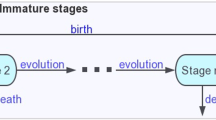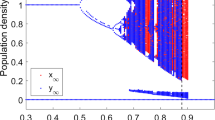Abstract
The coexistence of periodic and point attractors has been confirmed for a range of stage-structured discrete time models. The periodic attractor cycles have large amplitude, with the populations cycling between extremely low and surprisingly high values when compared to the equilibrium level. In this situation a stable state can be shocked by noise of sufficient strength into a state of high volatility. We found that the source of these large amplitude cycles are Arnol’d tongues, special regions of parameter space where the system exhibits periodic behaviour. Most of these tongues lie entirely in that part of parameter space where the system is unstable, but there are exceptions and these exceptions are the tongues that lead to attractor coexistence. Similarity in the geometry of Arnol’d tongues over the range of models considered might suggest that this is a common feature of stage-structured models but in the absence of proof this can only be a useful working hypothesis. The analysis shows that although large amplitude cycles might exist mathematically they might not be accessible biologically if biological constraints, such as non-negativity of population densities and vital rates, are imposed. Accessibility is found to be highly sensitive to model structure even though the mathematical structure is not. This highlights the danger of drawing biological conclusions from particular models. Having a comprehensive view of the different mechanisms by which periodic states can arise in families of discrete time models is important in the debate on whether the causes of periodicity in particular ecological systems are intrinsic, environmental or trophic. This paper is a contribution to that continuing debate.
Similar content being viewed by others
References
Arnold, V.I.: Geometrical Methods in the Theory of Ordinary Differential Equations. New York: Springer-Verlag, 1983
Beddington, J.R., Free, C.A., Lawton, J.H.: Dynamic Complexity in predator-prey models framed in difference equations. Nature 255, 58–60 (1975)
Berryman, A.A.: The Theory and Classification of Outbreaks. In: Barbosa, P., Schultz, J.C. (eds.), Insect Outbreaks, San Diego: Academic Press, 1987
Berryman, A.A.: Food web connectance and feedback dominance, or does everything really depend on everything else? OIKOS 68, 183–185 (1993)
Berryman, A.A.: Do Trophic Interactions Cause Population Cycles? In: Berryman, A.A. (ed.), Population Cycles: The Case for Trophic Interactions, Oxford, UK: Oxford University Press, 2002
Bjornstad, O.N., Fromentin, J., Stenseth, N.C., Gjosaeter, J.: Cycles and trends in cod populations. Proc. Natl. Acad. Sci. USA 96, 5066–5071 (1999)
Blarer, A., Doebeli, M.: Resonance effects and outbreaks in ecological time series. Ecol. Lett. 2, 167–177 (1999)
Caswell, H.: Matrix Population Models. Sunderland, Massachusetts: Sinauer Associates Inc., 2001
Crowley, P.H., Nisbet, R.M., Gurney, W.S.C., Lawton, J.H.: Population regulation in animals with complex life-histories: Formulation and analysis of the damselfly model. Adv. Ecol. Res. 17, 1–58 (1987)
Cushing, J.M., Costantino, R.F., Dennis, B., Desharnais, R.A., Henson, S.M.: Nonlinear population dynamics: models, experiments and data. J. theor. Biol. 194, 1–9 (1998)
Cushing, J.M., Henson, S.M., Desharnais, R.A., Dennis, B., Costantino, R.F., King, A.: A chaotic attractor in ecology: theory and experimental data. Chaos, Solitons and Fractals 12, 219–234 (2001)
Dennis, B., Desharnais, R.A., Cushing, J.M., Costantino, R.F.: Nonlinear Demographic Dynamics: Mathematical Models, Statistical Methods, and Biological Experiments. Ecol. Monogr. 65, 261–281 (1995)
Dietz, K.: The incidence of infectious diseases under the influence of seasonal fluctuations. Lecture Notes: Biomathematics 11, New York: Springer-Verlag, 1976, pp. 1–15
Gambaudo, J.M.: Perturbation of a Hopf Bifurcation by an External Time-Periodic Forcing. J. Diff. Eqns. 57, 172–199 (1985)
Geritz, S.A.H., Kisdi, E., Meszena, G., Metz, J.A.J.: Evolutionary singular strategies and the adaptive growth and branching of the evolutionary tree. Evolutionary Ecology 12, 35–57 (1998)
Ginzburg, L.R., Taneyhill, D.E.: Population cycles of forest Lepidoptera: a maternal effect hypothesis. J. Anim. Ecol. 63, 79–92 (1994)
Greenman, J.V., Benton, T.G.: The amplification of environmental noise in population models: causes and consequences. Am. Nat. 161, 225–239 (2003)
Greenman, J.V., Kamo, M., Boots, M.: External Forcing of Ecological and Epidemiological Systems: a resonance approach. Physica D 190, 136–151 (2004)
Guckenheimer, J., Oster, J.G., Ipaktchi, A.: The dynamics of density dependent population models. J. Math. Biol. 4, 101–147 (1977)
Gurney, W.S.C., Nisbet, R.M.: Ecological Dynamics. Oxford, UK: Oxford University Press, 1998
Henson, S.M.: Multiple attractors and resonance in periodically forced population models. Physica D 140, 33–49 (2000)
Higgins, K., Hastings, A., Sarvela, J.N., Botsford, L.W.: Stochastic Dynamics and Deterministic Skeletons: Population Behavior of Dungeness Crab. Science 276, 1431–1435 (1997)
Inchausti, P., Ginzburg, L.R.: Small mammals cycles in northern Europe: patterns and evidence for the maternal effect hypothesis. J. Anim. Ecol. 67, 180–194 (1998)
Kaitala, V., Ranta, E., Lindström, J.: Cyclic population dynamics and random perturbations. Ecology 65, 249–251 (1996)
Kaitala, V., Ylikarjula, J., Heino, M.: Dynamic complexities in host-parasitoid interaction. J. theor. Biol. 197, 331–341 (1999)
Katok, A., Hasselblatt, B.: Introduction to the Modern Theory of Dynamical Systems. Cambridge, UK: Cambridge University Press, 1998
Kendall, B.E., Prendergast, J., Bjornstad, O.N.: The macroecology of population dynamics: taxonomic and biogeographic patterns in population cycles. Ecol. Lett. 1, 160–164 (1998)
Kendall, B.E., Briggs, C.J., Murdoch, W.W., Turchin, P., Ellner, S.P., McCauley, E., Nisbet, R.M., Wood, S.N.: Why do populations cycle? A synthesis of statistical and mechanistic modelling approaches. Ecology 80, 1789–1805 (1999)
King, A.A., Schaffer, W.M.: The rainbow bridge: Hamiltonian limits and resonance in predator-prey dynamics. J. Math. Biol. 39, 439–469 (1999)
King, A.A., Schaffer, W.M.: The geometry of a population cycle: a mechanistic model of snowshoe hare demography. Ecology 82, 814–830 (2001)
Kon, R., Takeuchi, Y.: The Effect of Evolution on Host-Parasitoid Systems. J. theor. Biol. 209, 287–302 (2001)
Kuznetsov, Y.A., Piccardi, C.: Bifurcation analysis of periodic SEIR and SIR epidemic models. J. Math. Biol. 32, 109–121 (1994)
Kuznetsov, Y.A.: Elements of Applied Bifurcation Theory. New York: Springer-Verlag, 1995
Lauwerier, H.A., Metz, J.A.J.: Hopf Bifurcation in Host-Parasitoid Models. IMA Jl. Math. Med. Biol. 3, 191–210 (1986)
Lauwerier, H.A.: Two-dimensional iterative maps. In: A.V. Holden, (ed.), Chaos, Manchester, UK: Manchester University Press, 1986
Leslie, P.H.: On the use of matrices in certain population mathematics. Biometrika 33, 213–245 (1945)
Liebhold, A., Elkinton, J., Williams, D., Muzika, R.M.: What causes outbreaks of the gypsy moth in North America? Popul. Ecol. 42, 257–266 (2000)
Lima, M., Brazeiro, A., Defeo, O.: Population dynamics of the yellow clam Mesodesma mactroides: recruitment variability, density-dependence and stochastic processes. Mar. Ecol. Prog. Ser. 207, 97–108 (2000)
Maron, J.L., Harrison, S., Greaves, M.: Origin of an insect outbreak: escape in space or time from natural enemies? Oecologia 126, 595–602 (2001)
Marrow, P., Dieckmann, U., Law, R.: Evolutionary Dynamics of Predator-Prey Systems: An Ecological Perspective. J. Math. Biol. 34, 556–578 (1996)
May, R.M.: Biological populations with nonoverlapping generations: stable points, stable cycles and chaos. Science 186, 645–647 (1974)
May, R.M.: Simple mathematical models with very complicated dynamics. Nature 261, 459–467 (1976)
McCauley, E., Nisbet, R.M., Murdoch, W.W., de Roos, A.M., Gurney, W.S.C.: Large-amplitude cycles of Daphnia and its algal prey in enriched environments. Nature 402, 653–656 (1999)
Murdoch, W.W., Kendall, B.E., Nisbet, R.M., Briggs, C.J., McCauley, E., Bolser, R.: Single-species models for many-species food webs. Nature 417, 541–543 (2002)
Myers, J.H.: Can a general hypothesis explain population cycles of forest Lepidoptera? Adv. Ecol. Res. 18, 179–242 (1988)
Nagashima, H., Baba, Y.: Introduction to Chaos. Bristol, UK: Institute of Physics Publishing, 1999
Neimark, Y.I.: On some cases of periodic motion depending on parameters. Dokl. Akad. Nauk SSSR 129, 736–739 (1959)
Neubert, M.G., Caswell, H.: Density-dependent vital rates and their population dynamic consequences. J. Math. Biol. 41, 103–121 (2000)
Nicholson, A.J., Bailey, V.A.: The balance of animal populations. Proc. Zoolog. Soc. London 3, 551–598 (1935)
Nisbet, R.M., Onyiah, L.C.: Population dynamic consequences of competition within and between age classes. J. Math. Biol. 32, 329–344 (1994)
Ricker, W.E.: Stock and Recruitment. J. Fish. Res. Board Can. 11, 559–623 (1954)
Rohani, P., Wearing, H.J., Cameron, T., Sait, S.M.: Natural enemy specialization and the period of population cycles. Ecol. Lett. 6, 381–384 (2003)
Royama, T.: Analytical population dynamics. London: Chapman and Hall, 1992
Sacker, R.S.: On invariant surfaces and bifurcations of periodic solutions of ordinary differential equations. Commun. Pure and Appl. Math. 18, 717–732 (1965)
Stenseth, N.C., Falck, W., Bjornstad, O.N., Krebs, C.J.: Population regulation in snowshoe hare and Canadian lynx: Asymmetric food web configurations between hare and lynx. Proc. Natl. Acad. Sci. USA 94, 5147–5152 (1997)
Tanhuanpää, M., Ruohomäki, K., Turchin, P., Ayres, M.P., Bylund, H., Kaitaniemi, P., Tammaru, T., Haukioja, E.: Population Cycles of the Autumnal Moth in Fennoscandia. In: Berryman, A. (ed.), Population cycles, Oxford, UK: Oxford University Press, 2002
Tuljapurkar, S.: Population Dynamics in Variable Environments. Lecture Notes in Biomathematics, vol. 85, New York: Springer-Verlag, 1990
Turchin, P.: Rarity of density dependence or population regulation with lags? Nature 344, 660–663 (1990)
Turchin, P., Briggs, C.J., Ellner, S.P., Fischlin, A., Kendall, B.E., McCauley, E., Murdoch, W.W., Wood, S.N.: Population cycles of the Larch Budmoth in Switzerland. In: Berryman, A. (ed.), Population cycles, Oxford, UK: Oxford University Press, 2002
Wolfram, S.: The Mathematica Book. Cambridge, UK: Cambridge University Press, 1999
Author information
Authors and Affiliations
Corresponding author
Rights and permissions
About this article
Cite this article
V. Greenman, J., Benton, T. Large amplification in stage-structured models: Arnol’d tongues revisited. J. Math. Biol. 48, 647–671 (2004). https://doi.org/10.1007/s00285-004-0264-8
Received:
Revised:
Published:
Issue Date:
DOI: https://doi.org/10.1007/s00285-004-0264-8




